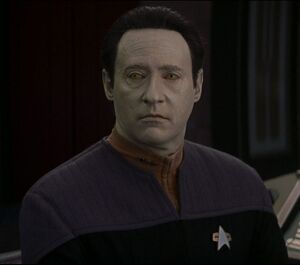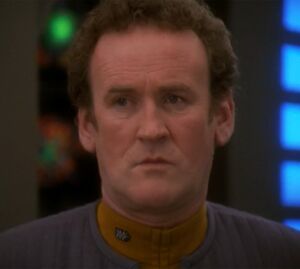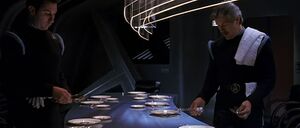Operations Department
More actions
Operations is the department responsible both for managing resources for their unit and for the maintenance and operation of non-structural, non-propulsive systems, such as transporters, replicators, computers, communications arrays (on units without a communications department), holodecks, sensors, life support and environmental systems, and waste management. The largest units have multiple sections under this department for each of these areas, while the smallest units must share crew members between this department and engineering.
On some bases, especially smaller ones, this department replaces engineering entirely, the example being Deep Space 9.
Standard Operations Department Positions
Chief Operations Officer

Assistant Chief Operations Officer
The Assistant Chief Operations Officer is second-in-command of the operations department, assisting their department head in their duties and coordinating with the executive officer to form duty rosters. Like the department head, they typically work on the bridge or station operations as operations manager, but also work with any section chiefs under them and other operations officers to perform other duties around the ship.
Operations Officer
Most units have a few generalist operations officers, who server as operations manager for a particular shift. On larger ships, this is a role generally reserved for officers at the rank of at least lieutenant junior grade (though as seen with Harry Kim above, this isn't a rule for smaller ships) as operations manager is a critical bridge role. Operations officers on smaller ships will also rotate through the responsibilities section chiefs would have on larger ships (waste management, logistics, communications, environmental control, etc.).
Relief Operations Officer
Relief Operations Officers are generally ensigns still in training to be entrusted with being operations managers for an entire shift. They are on-call for a particular shift, usually waiting in a room adjacent to the bridge or station operations, where they can quickly take over for a more senior officer at their station, should that officer be called away for some reason. They may occasionally also serve as operations manager for an entire shift, such as the night shift, and this is considered a training role, where they can accumulate enough hours of bridge time to be considered fully-qualified.
Transporter Chief

Additional Operations Department Positions
Not every ship will have an officer or chief running all of these sections, but they are representative of the types of sections which might be found under the Operations Department. On ships without a dedicated Communications Department, a Communications Section would work like the sections described here do.
Supply Operations Officer (Quartermaster)
Supply Operations Officers (informally known as quartermasters) are responsible for the fabrication, storage, and maintenance of hand-held equipment (such as tricorders) and other supplies, as well as for overseeing the ship's food and industrial replicators. They lead the Supply Section. Generally, they are junior officers, but a Chief Petty Officer could lead this section as Chief of Supply Operations.
Cargo Operations Officer
Cargo Operations Officers are responsible for the storage, safety, and transport of cargo aboard a starship or station, which includes making sure that containers are safely stowed, both in the right environmental conditions and secured in a way that they can't come loose and cause damage to the ship or station. They lead the Cargo Operations. Generally, they are junior officers, but a Chief Petty Officer could lead this section as Chief of Cargo Operations.
Environmental Operations Officer
Environmental Operations Officers are responsible for ensuring that the environmental control systems are maintained and operated within regulation. Generally speaking, these systems are highly redundant and difficult to damage because of how critical they are, so officers in this section serve as a safeguard to verify that automated processes are proceeding correctly. They would also be needed when any being with unusual environmental needs comes aboard. Generally, they are junior officers, but a Chief Petty Officer could lead this section as Chief of Environmental Operations.
Computer Operations Officer
Computer Operations Officers are responsible for the operation and routine maintenance of the ship's computer systems, especially when it comes to user access rights, data integrity, and software updates. Secondary functions include cybersecurity and portable hardware maintenance. Generally, they are junior officers, but a Chief Petty Officer could lead this section as Chief of Computer Operations.
Holography Operations Officer
Holography Operations Officers are responsible for the operation and maintenance of the holodecks, as well as hologrids in other locations on stations and starships that are so equipped. By 2399, this is an extremely important system, due to the omnipresence of emergency and assistive holoprograms, such as the EMH, LMH, ECH, etc. Generally, they are junior officers, but a Chief Petty Officer could lead this section as Chief of Holography Operations.
Waste Management Operations Officer
Waste Management Officers deal with processing waste and recycling it into the appropriate systems, which ranges from sanitation to breaking down unused equipment. It is not a popular position. Generally, they are junior officers, but a Chief Petty Officer could lead this section as Chief of Holography Operations.
Special Services Officer

Operations Specialist (Yeoman)
Operations Specialists are members of Starfleet in the enlisted grades assigned to the Operations Department. There are many generalist Operations Specialists on any large command, as well as specialists within each section, who would take their position title from that section. (e.g. Computer Operations Specialist, Waste Management Operations Specialist, etc.). Generalists would normally be those personnel ranked as Crewmen, while specialists would have the rank of Petty Officer Third Class and above. Generalists are sometimes known in short-hand as yeomen, and are often who is called when things need to be moved from room to room, or other low-level logistics tasks.
Boatswain
Pronounced "bosun," the boatswain is the senior-most enlisted member of the operations department, who is responsible for the training of other enlisted members of the department. According to naval tradition, the boatswain should be present to greet anyone of any importance arriving aboard the starship, but this is normally dispensed with and the duty of piping aboard dignitaries (with a whistle or other instrument) is left to a yeoman, or even to the ship's computer. Not all units, especially small units, have an individual with this title, but Operations Departments generally have a large number of enlisted members, so this position is the most common of all of the special titles for senior enlisted members.
Operations Department In-Play
- Engineering makes the ship move, but Operations makes it run. Resources are allocated, power is shunted, and transporters are run from here.
- Enlisted members of this department do a lot of the menial labor on the ship, such as moving cargo from one bay to another.
- Operations deals with all of the fiddly, technical systems that are essential for starships to accomplish their mission but which aren't found in the engine room.
- The sections outlined in the above section would all need to be accounted for on any unit, but only medium-large ships and stations would have an officer in every role. Being an ops officer means pulling double-duties to keep the clock ticking smoothly.
- On DS9, Miles O'Brien was Chief of Operations, not Chief of Engineering, presumably because DS9 had no engines or propulsive technology to maintain, and as such this department could be combined with the relevant positions from engineering, especially on smaller stations.
